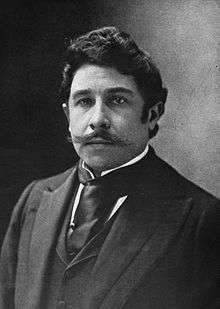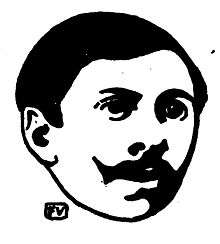Paul Adam (French novelist)
Paul Adam (December 7, 1862 – January 2, 1920) was a French novelist who became an early proponent of Symbolism in France, and one of the founders of the Symbolist review Le Symboliste.[1]


Career overview
Adam's first novel, Chair molle ("Soft Flesh"), was the story of a prostitute in the Naturalist manner, which led to him being prosecuted for immorality before the Cour d'assises and sentenced to a fortnight in prison and a 500-franc fine.[2] Together with Jean Moréas, he co-wrote Les Demoiselles Goubert, a novel that marked the transition between Naturalism and Symbolism in French literature. His Lettres de Malaisie (1897) was speculative fiction about politics in the future.[1] He also wrote a series of historical novels that dealt with the period of the Napoleonic Wars and their aftermath; the first installment in the series, La Force, was published in 1899. It was followed by L'enfant d'Austerlitz (1901), La ruse (1902) and Au soleil de Juillet (1903).[1] His novel Stephanie, which appeared in 1913, argued in favour of arranged marriages as opposed to those founded on romantic attachments.
He was born and died in Paris.[3]
Works
- Chair molle (1885)
- Soi (1886)
- Les Demoiselles Goubert (with Jean Moréas, 1886)
- Le Thé chez Miranda (with Jean Moréas, 1886)
- La glèbe (1887)
- Les Volontés merveilleuses: Être (1888)
- Les Volontés merveilleuses: L'essence de soleil (1890)
- Les Volontés merveilleuses: en décor (1890)
- L'Époque: Le Vice filial (1891)
- L'Époque: Robes rouges (1891)
- L'Époque: Les Cœurs utiles (1892)
- L'Automne (1893, a censored play)
- Le Conte futur (1893)
- Critique des mœurs (1893)
- Les Images sentimentales (1893)
- Princesses byzantines (1893)
- La Parade amoureuse (1894)
- Le Mystère des foules (1895)
- Les Cœurs nouveaux (1896)
- La Force du mal (1896)
- L'Année de Clarisse (1897, illustrated by Gaston Darbour)
- La bataille d'Uhde (1897)
- Le Vice filial (1898, illustrated by Jan Dědina)
- Le Temps et la Vie:
- La Force (1899)
- L'Enfant d'Austerlitz (1901)
- La Ruse, 1827-1828 (1903)
- Au soleil de juillet, 1829-1830 (1903)
- Basile et Sophia (1901)
- Lettres de Malaisie (1898)
- Le Troupeau de Clarisse (1904)
- Le Serpent noir (1905)
- Vues d'Amérique (1906)
- Clarisse et l'homme heureux (1907)
- La Morale des Sports (1907)
- La cité prochaine (1908)
- Les Impérialismes et la morale des peuples (1908)
- Le Malaise du monde latin (1910)
- Le Trust (1910)
- Contre l’Aigle (1910)
- Stéphanie (1913)
- Le Lion d'Arras (1919)
- Notre Carthage (1922)
- Dieu (1924, published posthumously in La Phalange)
References
- "Adam, Paul". Encyclopaedia Britannica. 1 (14 ed.). 1930. p. 149.
- Robert Netz, Histoire de la censure dans l'édition (Presses Universitaires de France, 1997), p. 124.
- "Paul Adam". Encyclopædia Britannica.
- Chisholm, Hugh, ed. (1911). . Encyclopædia Britannica (11th ed.). Cambridge University Press.
External links
| Wikimedia Commons has media related to Paul Adam. |
- Works by Paul Adam at Project Gutenberg
- Works by or about Paul Adam at Internet Archive
- Works by Paul Adam at Hathi Trust
- Signac, 1863-1935, a fully digitized exhibition catalog from The Metropolitan Museum of Art Libraries, which contains material on Paul Adam (see index)